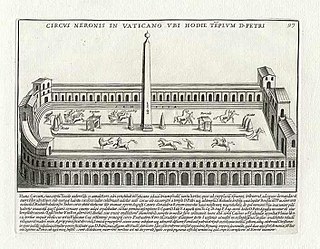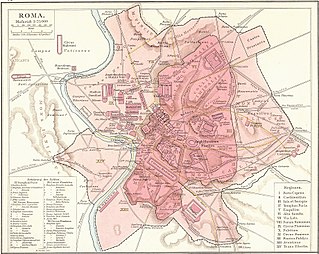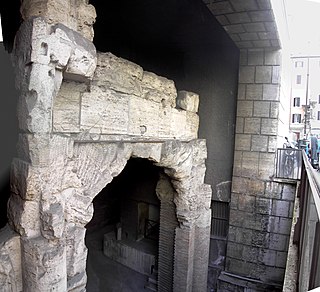 W
WAqua Anio Novus was an ancient Roman aqueduct. Like the Aqua Claudia, it was begun by emperor Caligula in 38 AD and completed in 52 AD by Claudius, who dedicated them both on August 1. Together with the Aqua Anio Vetus, Aqua Marcia and Aqua Claudia, it is regarded as one of the "four great aqueducts of Rome."
 W
WAqua Claudia, was an ancient Roman aqueduct that, like the Aqua Anio Novus, was begun by Emperor Caligula in 38 AD and finished by Emperor Claudius in 52 AD.
 W
WThe Patriarchate of Aquileia was an episcopal see in northeastern Italy, centred on the ancient city of Aquileia situated at the head of the Adriatic, on what is now the Italian seacoast. For many centuries it played an important part in history, particularly in that of the Holy See and northern Italy, and a number of church councils were held there.
 W
WThe Arch of Titus is a 1st-century AD honorific arch, located on the Via Sacra, Rome, just to the south-east of the Roman Forum. It was constructed in c. 81 AD by the Emperor Domitian shortly after the death of his older brother Titus to commemorate Titus's official deification or consecratio and the victory of Titus together with their father, Vespasian, over the Jewish rebellion in Judaea. The arch contains panels depicting the triumphal procession celebrated in 71 AD after the Roman victory culminating in the fall of Jerusalem, and provides one of the few contemporary depictions of artifacts of Herod's Temple. It became a symbol of the Jewish diaspora, and the menorah depicted on the arch served as the model for the menorah used as the emblem of the state of Israel.
 W
WThe lesser-known Arch of Titus was a triple bay arch erected at the eastern end of the Circus Maximus by the Senate in A.D. 81, in honour of Titus and his capture of Jerusalem in the First Jewish–Roman War. Few traces remain. The inscription, quoted by an 8th-century Swiss monk known only as the "Einsiedeln Anonymous", makes it clear that this was Titus' triumphal arch. Sculptural fragments of a military frieze have been attributed to the arch.
 W
WThe Baths of Titus or Thermae Titi were public baths (Thermae) built in 81 AD at Rome, by Roman emperor Titus. The baths sat at the base of the Esquiline Hill, an area of parkland and luxury estates which had been taken over by Nero for his Golden House or Domus Aurea. Titus' baths were built in haste, possibly by converting an existing or partly built bathing complex belonging to the reviled Domus Aurea. They were not particularly extensive, and the much larger Baths of Trajan were built immediately adjacent to them at the start of the next century.
 W
WThe Circus of Nero or Circus of Caligula was a circus in ancient Rome, located mostly in the present-day Vatican City.
 W
WThe Diocese of Rome is the ecclesiastical district under the direct jurisdiction of the Pope, who is Bishop of Rome as well as the supreme pontiff and leader of the worldwide Catholic Church. As the Holy See, the papacy is a sovereign entity with diplomatic relations, and civil jurisdiction over the Vatican City State located geographically within Rome. The Diocese of Rome is the metropolitan diocese of the Province of Rome, an ecclesiastical province in Italy. The first bishop of Rome was Saint Peter in the first century. The incumbent since 13 March 2013 is Pope Francis.
 W
WThe Diocese of Fiesole is a Roman Catholic diocese in Tuscany, central Italy, whose episcopal see is the city of Fiesole. Fiesole was directly subject to the pope until 1420, when the archdiocese of Florence was created and Fiesole was made one of its suffragan bishops. It is still a suffragan of the Metropolitan Archbishopric of Florence.
 W
WThe Flavian Amphitheater, located in Pozzuoli, is the third-largest Roman amphitheater in Italy. Only the Roman Colosseum and the Amphitheatre of Capua are larger. It was likely built by the same architects who previously constructed the Roman Colosseum. The name "Flavian Amphitheater" is primarily associated with the Roman Colosseum.
 W
WThe Colosseum, is an oval amphitheatre in the centre of the city of Rome, Italy, just east of the Roman Forum and is the largest ancient amphitheatre ever built. Construction began under the emperor Vespasian in 72 and was completed in AD 80 under his successor and heir, Titus. Further modifications were made during the reign of Domitian. The three emperors that were patrons of the work are known as the Flavian dynasty, and the amphitheatre was named the Flavian Amphitheatre by later classicists and archaeologists for its association with their family name (Flavius).
 W
WThe Flavian Palace, normally known as the Domus Flavia, is part of the vast Palace of Domitian on the Palatine Hill in Rome. It was completed in 92 AD by Emperor Titus Flavius Domitianus, and attributed to his master architect, Rabirius.
 W
WForum of Nerva is an ancient structure in Rome, Italy, chronologically the next to the last of the Imperial fora built.
 W
WThe Pons Neronianus or Bridge of Nero was an ancient bridge in Rome built during the reign of the emperors Caligula or Nero to connect the western part of the Campus Martius with the Campus Vaticanus, where the Imperial Family owned land along the Via Cornelia.
 W
WThe Ostia Synagogue is an ancient synagogue located in ancient Ostia, the seaport of Imperial Rome. It is one of the oldest synagogues in the world, the oldest synagogue in Europe and the oldest mainstream Jewish synagogue yet uncovered outside Israel. The synagogue building dates from the reign of Claudius and continued in use as a synagogue into the 5th century AD.
 W
WPortus was a large artificial harbour of Ancient Rome. Sited on the north bank of the north mouth of the Tiber, on the Tyrrhenian coast, it was established by Claudius and enlarged by Trajan to supplement the nearby port of Ostia.
 W
WThe Archdiocese of Milan is a metropolitan see of the Catholic Church in Italy which covers the areas of Milan, Monza, Lecco and Varese. It has long maintained its own Latin liturgical rite, the Ambrosian rite, which is still used in the greater part of the diocesan territory. Among its past archbishops, the better known are Saint Ambrose, Saint Charles Borromeo, Pope Pius XI and Saint Pope Paul VI.
 W
WThe Roman Catholic Archdiocese of Naples is a Roman Catholic Archdiocese in southern Italy, the see being in Naples. A Christian community was founded there in the 1st century AD and the diocese of Naples was raised to the level of an Archdiocese in the 10th century. Two Archbishops of Naples have been elected Pope, Paul IV and Innocent XII.
 W
WThe Stadium of Domitian, also known as the Circus Agonalis, was located to the north of the Campus Martius in Rome, Italy. The Stadium was commissioned around AD 80 by the Emperor Titus Flavius Domitianus as a gift to the people of Rome, and was used mostly for athletic contests.
 W
WThe Temple of Vespasian and Titus is located in Rome at the western end of the Roman Forum between the Temple of Concordia and the Temple of Saturn. It is dedicated to the deified Vespasian and his son, the deified Titus. It was begun by Titus in 79 after Vespasian's death and Titus's succession. Titus’ brother, Domitian, completed and dedicated the temple to Titus and Vespasian in approximately 87.
 W
W(N.B. The via Domitiana is not to be confused with the similar-sounding via Domitia in France.)